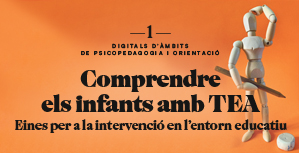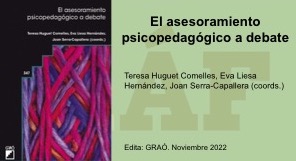THE PROBLEM OF BEHAVIOR IN CATALONIA'S CHILDREN AND TEENORS: descriptive study of attention deficit disorder
Behavior disorder. An epistemological reflection
Abstract
In recent years, both the media and communities of professionals from different fields (health, education, social, justice) have been warning of increased conflict and disruptive situations that arise in educational frameworks and in the family. The lack of respect to the adult, the lack of boundaries and the lack of agreements between families and teachers, appear as issues of concern to educators - families and teachers - and subject them to strong tensions that sometimes may lead to personal and professional crises. This study aims to determine the nature of these problems and their consequences for those involved and the possible solutions. At the same time, it points to an epistemological reflection on the problem of attention versus executive functions.
References
Anguera M. T. i Moya, J. (2010). Problemes de comportament en els infants i adolescents de Catalunya.necessitats educatives que generen. Departament d’Educació i Departament de Salut de la Generalitat de Catalunya.
Armas, M. (2002). La supervisión como estrategia de intervención a profesionales y novatos de la educación. A M. Alvarez i R. Bisquerra (eds.), Manual de orientación y tutoría (pp. 23-26). Barcelona: Praxis.
Barkley, R. (2007). Niños hiperactivos. Cómo comprender y atender sus necesidades especiales. Barcelona: Paidós.
Brown, Th. (2006). Trastorno por déficit de atención. Barcelona: Masson.
Camps, V. (2008). Creer en la educación. Barcelona: Península.
Cordié, A. (1998). Malestar del docente. Buenos Aires: Nueva Visión.
Fernández, C. (2008). El aula desierta. Barcelona: Montesinos.
Elliot, M. (2008). Intimidación. México: Fondo de Cultura Económica.
Hallowell, E. y Ratey, J.(2001). TDA: controlando la hiperactividad. Barcelona: Paidós.
Harwood, V. (2009). El diagnóstico de los niños y adolescentes problemáticos. Una crítica a los discursos sobre los trastornos de la conducta. Madrid: Morata
House, A. (2003). DSM – IV. El diagnóstico en la edad escolar. Madrid: Alianza Editorial.
Krueger, R. (1988). Grupos de discusión. Madrid: Pirámide.
Marina, J.A. (2009). La recuperación de la autoridad. Barcelona: Versàtil.
Mateer, C.A.; Mapou, R.L. (1996). Understanding, evaluating, and managing attention disorders following traumatic brain injury. J. Head Trauma Rehabil; 11: 1-16
Parasuranam, R.( 1998). The attentive brain: Issues and prospects. A Parasuranam R. Ed. The attentive brain. London: MIT Press.
Ríos, M.; Periáñez, J.A.; Rodríguez-Sánchez, J.M. (2011). Neuropsicología de la atención. A J. Tirapu, M. Ríos F. Maestú (Ed). Manual de Neuropsicología. Barcelona: Viguera.
Roselló, J; Munar, E.; Garrido, M.J. (2001). La naturaleza de la atención visual: ¿monarquía, oligarquía o anarquía? Revista de Psicología General y Aplicada; 54:31-46
Schachar, R. i Ickowicz, A. (2003). Trastornos hipercinéticos con deficit de atención en la infancia y la adolescencia. A Michel G. Selder, Juan J. López-Ibor y Nancy Andreasen (Ed.). Tratado de psiquiatría. Vol III. Barcelona: Ars Medica (pp: 2097-2111).
Sholberg, M.M.; Johnson L.; Paule, L. I cols (1994). Attention Process Training II: a program to address attentional deficits for persons with mild cognitive dysfunction. Puyallub, WA: Association for Neuropsychological Reserach and Development.
Soutullo C. I Díez, A. (2007). Manual de diagnóstico y tratamiento del TDAH. Buenos Aires: Panamericana.
Soutullo, C.; Mardomingo, MJ. (2010). Manual de Psiquiatría del Niño y del Adolescente. Buenos Aires, Madrid: Panamericana.
Tirapu, J. i Luna, P. (2011). Neuropsicología de las funciones ejecutivas. A Neuropsicología de la atención. A J. Tirapu, M. Ríos F. Maestú (Ed). Manual de Neuropsicología. Barcelona: Viguera (pp: 221-259).
Ubieto, J.R. (2009). El trabajo en red. Usos posibles en educación, Salud Mental y Servicios Sociales. Barcelona: Gedisa.
Weitzman, E.A. (2000). Software and qualitative research. In N. Denzin y Y.S. Lincoln (Comps.), Handbook of qualitative research (pp. 803-820). London: Sage.
Downloads
Published
Issue
Section
License
The authors maintain their copyright and give the right to the first publication of the work to the journal, registered under a Creative Commons Attribution-Non Commercial-NoDerivs license. This license allows others to download the works and to share them with others as long as they credit the author, but it does not allow for any kind of modification or commercial use.















